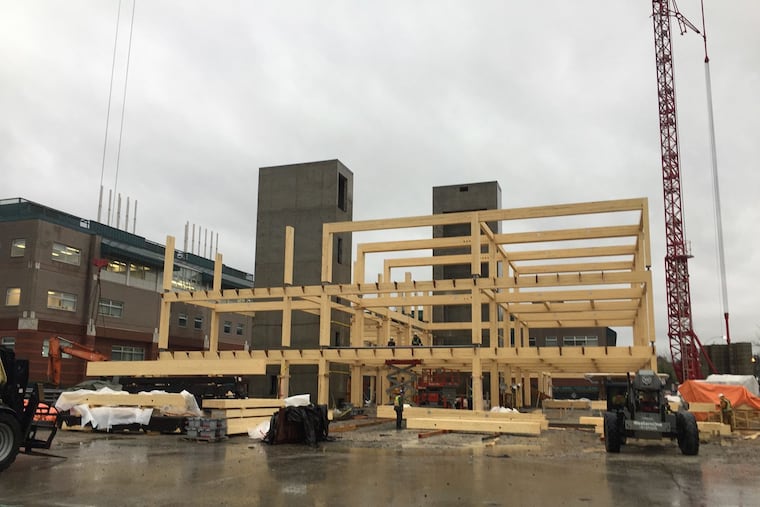Tall buildings out of timber? In the face of climate change, Seattle encourages it.
Cross-laminated timber is touted as an environmentally sustainable alternative to concrete and steel, which generate large quantities of greenhouse gases in their production. Loggers and environmentalists see it as a response to climate change.

The loggers who made Seattle a center of the national timber industry are long gone. Only a few wooden landmarks of the timber heyday, mostly churches, still exist on the low-slung skyline of the city’s Ballard neighborhood.
But as concerns over climate change give new life to wooden building design, that could change.
Ballard will soon be home to Seattle’s first tall building built almost entirely from wood. Rising eight stories atop a florist shop will be a hotel built principally from cross-laminated timber (CLT) — durable panels made from binding layers of wooden planks with adhesive.
Cross-laminated timber is touted as an environmentally sustainable alternative to concrete and steel, which generate large quantities of greenhouse gases in their production. Loggers and environmentalists alike say that building with cross-laminated timber needs to be part of the response to climate change.
For those who remember the fiery 1990s protests over logging in the spotted owl’s Olympic Peninsula habitat, building with wood seems counterintuitive.
Mark Wishnie, director of global forestry at the Nature Conservancy, understands the whiplash that some feel about the environmental movement’s about-face on timber. One of the biggest challenges to increasing demand for CLT construction, he said, is the “scars in people’s memories” — the perception that logging equals deforestation. Cross-laminated timber makes sense, Wishnie said, only if the wood comes from a forest that’s managed responsibly.
Since an April code change made it easier for cross-laminated timber buildings to win Seattle’s approval, developers have applied for permits for three such towers, including the Ballard hotel — and local architects say plenty more are on their way.
Cross-laminated timber is a subset of mass timber — ultra-dense blocks of planks bound together with glue or nails. Mass timber is far from new: In 1982, the Tacoma Dome, a multipurpose arena, was framed with thousands of glue-laminated beams, a form of mass timber.
But until recently, architects weren’t able to envision building hundred-foot-plus towers entirely of wood because fire codes wouldn’t allow it.
Enter cross-laminated timber: Fire-resistant wood panels capable of replacing concrete in floors, walls, and ceilings. It’s produced in 12- by 60-foot panels and cut by computer into prefabricated patterns, ensuring a minimum of construction waste.
As the Seattle area continues to grow — by close to 600,000 people in the next 20 years, the state estimates — the city will need to balance the need to build new housing with the need to eliminate waste and carbon emissions from construction, environmentalists say.
The huge environmental benefits of cross-laminated timber are its biggest draw: Construction on a cross-laminated timber high-rise emits roughly 25% less carbon dioxide than if the high-rise were concrete, according to a University of Washington study.
Timber buildings also store atmospheric carbon locked in the trees used to build them. And greenhouse gases are sequestered even further as forestry land is replaced and new trees absorb carbon dioxide.
“When we take the wood out of the forest, we are planting new forest and sequestering new carbon,” said Indroneil Ganguly, associate professor at the University of Washington’s School of Environmental and Forest Sciences and one of the authors of the study. Building with timber, he said, is “almost like multiplying the acres of forest.”
Other Washington cities, including Spokane, and Portland, Ore., have embraced CLT to build apartment and condo buildings, hotels, and offices. And the University of British Columbia has been using the material for years.
All three of the buildings proposed in Seattle are concrete-CLT hybrids, and it’s unlikely an entirely wood tower will come to Seattle any time soon. That’s because codes encourage that some of the building’s earthquake-proofing elements be made from concrete — even though in theory, cross-laminated timber should perform well in an earthquake, said Erica Spiritos, preconstruction manager for Swinerton Mass Timber in Portland.
While Seattle technically allows 18-story cross-laminated timber towers, most projects will likely remain in a six- to 12-story “sweet spot” — too high to use traditional lumber because of fire safety, but too short to make the extra expense of reinforced concrete pencil out, architects say.
The cross-laminated timber panels will be prefabricated off-site, then lifted into place by a single crane in a matter of weeks, “like an Erector Set,” said architect Lauren Garkel, designer of two CLT projects. “The construction team is a handful of people with a drill.”
A study from the University of Washington and conservation group Forterra estimated that by 2040, local demand for cross-laminated timber would account for less than 1% of the annual Pacific Northwest timber harvest — so a CLT boom isn’t likely to create a huge number of new forestry jobs.
Yet some environmental concerns around logging remain. Even if demand for timber does increase, that could complicate rather than alleviate environmental problems unless foresters manage their land sustainably — meaning forest thinning, not clear-cutting; plenty of clearance around streams; and a longer growth cycle.
Meanwhile, environmentalists say no city is currently building cross-laminated timber structures fast enough to stave off the most devastating effects of climate change.
“If cross-laminated timber is going to make a difference for climate,” Wishnie said, “we’re going to need to rapidly scale it up.”